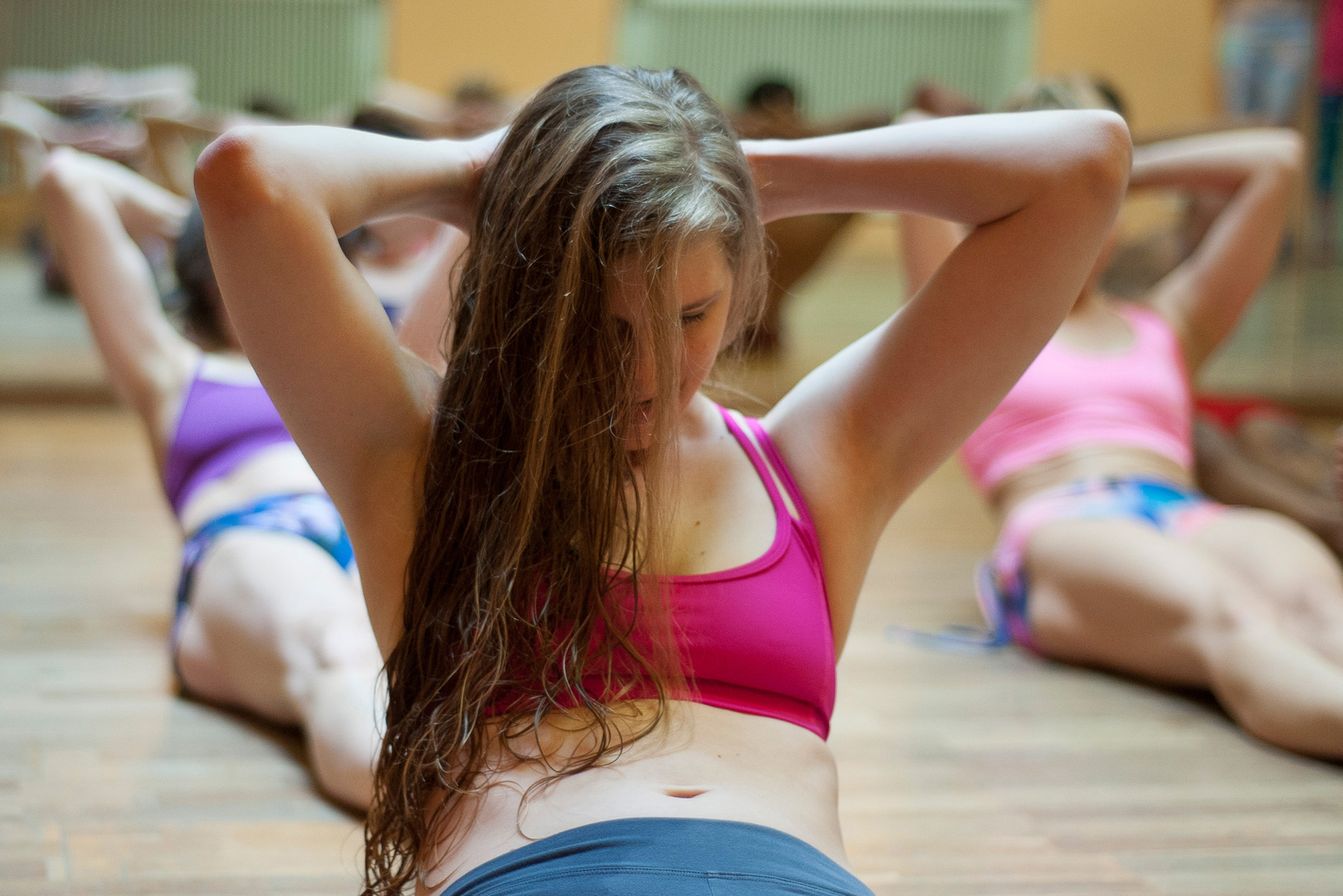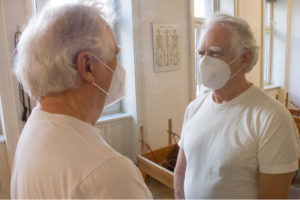The Roll Up takes pressure off our discs by releasing tension in the muscles along our spine.
Surely, you know this situation: You drop a pen, bend down to lift it, and suddenly feel a tension in your back. Or you bend down to your toddler feeling this slight tenseness in your discs. Sounds familiar? Well, this stiffness is caused by tight back fasciae.
The question is: How can we make the fascia in our back more flexible? How can we prevent this unnecessary back pain? The Pilates Roll Up will help us! How? I’ll show you in now. And let’s be especially careful that the healthy Roll Up exercise doesn’t become an unhealthy Roll In exercise. What do I mean by this?
How does the Roll Up relax my fasciae?
To release stuck fascia, the Roll Up must be performed in such a way that we roll forward and up – away from the mat. Unfortunately, however, the Roll Up is often performed in such a way that we roll inwards and sink down onto the mat. This is how we create a Roll In exercise – and, unfortunately, this does nothing to relax the fascia in our back. How to get around this faulty practice of the Roll Up? How do we perform the Roll Up in such a way that it contributes to the relaxation of our fascia? I’ll explain it to you with an example. But first we have to know that …
Only an articulated movement of my spine relaxes the fasciae in my back

The Roll Up takes pressure off our discs by releasing tension in the muscles along our spine. But this only happens if we bend our spine in a controlled and articulated manner. Only the controlled and articulated flexion throughout the movement releases tension in the muscles along the spine and we can relieve the strain on our intervertebral discs.
The Roll Up challenges the ability of our two main body centers – the deep muscle corset system and shoulder girdle stabilizers – to maintain spinal and pelvic stability during flexion.
Let’s take a closer look.
Our posture matters
In order to understand the challenges our student in the video below faces with the Roll Up, we must take his posture into consideration.
Does he lie in a functional position or not? Is his entire spine imprinted and grounded onto the mat? Is his pelvis in a functional neutral position? More specifically, is his pelvis in a position that anchors so that he can effectively oppose the movement of his ribcage as the spine rolls up? Are his arms extended above his head in such a way that they extend from the eccentric contraction of the shoulder girdle stabilisers? Does the extension of his arms happen independently of the elevation of his ribcage? Is his DMCS – deep muscle corset system better known as powerhouse – ready to fire? Even if you don’t understand half of the questions, just look closely at his posture at the beginning of the exercise in the video. I am sure you will understand better;) Click now and enjoy!
The importance of our pelvic position
What exactly is our student doing in the video above? As we can see, his head is in the correct chin-to-chest position as he rolls up and his shoulder girdle stabilizers are firing. However, his upper body is still prevented from moving forward and his chest is forced to sag inward. Why? Because of the collapse in his DMCS – the junction where his hamstrings, adductors, and gluteus meet his pelvis. The result is a dysfunctional posterior tilt in the pelvis.
In this position, he needs to overcome 2 forces – gravity and his own body weight. In order to do the Roll Up in this position, he has no choice but to unnaturally push his back onto the mat, which automatically lifts his legs into the air, and forces his DMCS – powerhouse – to work inefficiently.
Because of the dysfunctional posterior tilt in his pelvis, when he rolls down, his entire body weight shifts away from the centre towards his neck (7th cervical vertebra) and upper back (12th dorsal vertebra). As a result, he hyperextends his arms, and the distance from shoulder to shoulder is reduced. In this way, he cannot experience the benefit of the Roll Up.
What is the solution?
The functional neutral pelvic position – our salvation
Before he starts the Roll Up, he has to bring his pelvis into a functional neutral position. This means he needs to adjust his pelvis with the help of his DMCS – powerhouse – so that his 2 hip bones and his pubic bone are on the same level. It is important that he uses his powerhouse and not his lower back to bring his pelvis into a functional neutral position.
When he begins to roll up, he needs to activate his powerhouse to stabilise his pelvis in a functional posterior tilt. At the same time, he needs to fix his pelvis via his pubic bone to anchor his pelvis to his ribcage. This way he prevents the collapse in his lower back and the dysfunctional tilting of his pelvis. As he then continues to roll up, he also needs to activate his shoulder girdle to anchor his ribcage to his pelvis. Then, when rolling downwards, he must simultaneously lengthen his legs and upper body, and scoop his lower abdominals – powerhouse – in. This way he can move his pelvis by means of his pubic bone.
This way of practice will sequentially articulate his spine onto the mat, ground his legs and activate his shoulder girdle. This will ground his ribcage to his pelvis and allow him to continue the downward roll efficiently. It will also prevent the collapse of the 7th cervical spine, especially on the way down.
Watch the solution in the video below. Click now and enjoy:)
Mitigating physical dysfunctions through awareness
Because of his postural and functional habits, our student has to subcortically negotiate with 2 physical malfunction patterns
- the collapse of the 7th cervical spine and
- the sagging of the lower back.
These malfunctions most likely exist because he does not sit upright in the chair in front of the TV and computer, but sinks into the chair, which can cause our back fascia to be tight. Regular practice of the exercise principle suggested here would mitigate his physical dysfunction and also create more awareness for movement in day-to-day life. Now, it’s up to you!
Try it & fly with it!
Did you like our blog post? Then kindly support us and share it on social media sites like Facebook, Twitter, group forums, blogs and – all the retro way – personally among friends. We also highly appreciate your feedback on our exercises and posts.



